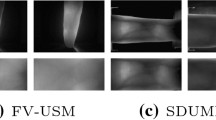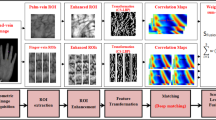Abstract
Automatic person recognition using finger-vein has been extensively investigated in recent years. Mostly the published research on biometrics are based on the hand-crafted feature descriptors to describe the appearance of a finger-vein image, which is prone to be affected by irregular shading, irrelevant background, varying illumination and non-rigid deformation. To improve the recognition performance of hand-crafted feature-based methods, many researchers have contributed substantially in designing enhancement methods for texture descriptors. However, hand-crafted algorithms are highly targeted with weak generalization ability with respect to the emerging data samples. Nowadays, deep convolutional neural networks (CNN) is emerging as a powerful technology to extract multi-level feature representation instead of traditionally designed features from raw data. These methods are achieving unprecedented performance in the field of computer vision. In context to biometrics modalities, finger-vein recognition using CNN is still in its primary stage. In this paper, we proposed a simple yet effective multi-scale arc-fusion approach to optimize the feature embedding discrimination power. An exhaustive comparative experiment is conducted on four publicly available databases: HKPU, FV-USM, SDUMLA and UTFVP, to demonstrate that the proposed approach is superior to the existing state-of-the-art (SOTA) methods. Also, the experimental result shows that the concept is actually scalable and can be migrated to other deep neural network architectures.









Similar content being viewed by others
Notes
[online] HKPU https://www4.comp.polyu.edu.hk/~csajaykr/fvdatabase.htm.
[online] FV-USM http://drfendi.com/fv_usm_database/.
[online] SDUMLA http://mla.sdu.edu.cn/info/1006/1195.htm.
[online] UTFVP https://www.utwente.nl/en/eemcs/dmb/downloads/utfvp/.
[online] PyTorch https://github.com/pytorch/pytorch.
References
Kumar A, Zhou Y (2011) Human identification using finger images. IEEE TIP 21(4):2228–2244
Menotti D, Chiachia G, Pinto A, Schwartz WR, Pedrini H, Falcao AX, Rocha A (2015) Deep representations for iris, face, and fingerprint spoofing detection. IEEE TIFS 10(4):864–879
Noh KS (2016) A study on the authentication and security of financial settlement using the finger vein technology in wireless internet environment. WPC 89(3):761–775
Zharov VP, Ferguson S, Eidt JF, Howard PC, Fink LM, Waner M (2004) Infrared imaging of subcutaneous veins. Lasers Surg Med Off J Am Soc Laser Med Surg 34(1):56–61
Yang J, Shi Y (2014) Towards finger-vein image restoration and enhancement for finger-vein recognition. Inf Sci 268:33–52
Syarif MA, Ong TS, Teoh AB, Tee C (2017) Enhanced maximum curvature descriptors for finger vein verification. MTAP 76(5):6859–6887
Chen L, Wang J, Yang S, He H (2016) A finger vein image-based personal identification system with self-adaptive illuminance control. IEEE TIM 66(2):294–304
Qiu S, Liu Y, Zhou Y, Huang J, Nie Y (2016) Finger-vein recognition based on dual-sliding window localization and pseudo-elliptical transformer. Expert Syst Appl 64:618–632
Kligvasser I, Shaham TR, Michaeli T (2018) xunit: learning a spatial activation function for efficient image restoration. In: CVPR, pp 2433–2442
Das R, Piciucco E, Maiorana E, Campisi P (2018) Convolutional neural network for finger-vein-based biometric identification. IEEE TIFS 14(2):360–373
Qin H, El-Yacoubi MA (2017) Deep representation for finger-vein image-quality assessment. IEEE TCSVT 28(8):1677–1693
Qin H, El-Yacoubi MA (2017) Deep representation-based feature extraction and recovering for finger-vein verification. IEEE TIFS 12(8):1816–1829
Xie C, Kumar A (2017) Finger vein identification using convolutional neural network and supervised discrete hashing. In: Deep Learning for Biometrics, pp. 109–132. Springer
Fang Y, Wu Q, Kang W (2018) A novel finger vein verification system based on two-stream convolutional network learning. Neurocomputing 290:100–107
Yang W, Luo W, Kang W, Huang Z, Wu Q (2020) Fvras-net: an embedded finger-vein recognition and antispoofing system using a unified cnn. IEEE TIM 69(11):8690–8701
Hao Z, Fang P, Yang H (2020) Finger vein recognition based on multi-task learning. In: ICMAI, pp. 133–140
Schroff F, Kalenichenko D, Philbin J (2015) Facenet: A unified embedding for face recognition and clustering. In: CVPR, pp. 815–823
Wimmer G, Prommegger B, Uhl, A (2021) Finger vein recognition and intra-subject similarity evaluation of finger veins using the cnn triplet loss. In: ICPR, pp. 400–406. IEEE
Deng J, Guo J, Xue N, Zafeiriou S (2019) Arcface: Additive angular margin loss for deep face recognition. In: CVPR, pp. 4690–4699
Song JM, Kim W, Park KR (2019) Finger-vein recognition based on deep densenet using composite image. IEEE Access 7:66845–66863
Boucherit I, Zmirli MO, Hentabli H, Rosdi BA (2020) Finger vein identification using deeply-fused convolutional neural network. Journal of King Saud University-Computer and Information Sciences
Wen Y, Zhang K, Li Z, Qiao Y (2016) A discriminative feature learning approach for deep face recognition. In: ECCV, pp. 499–515. Springer
Liu W, Wen Y, Yu Z, Yang M (2016) Large-margin softmax loss for convolutional neural networks. ICML 2:7
Liu W, Wen Y, Yu Z, Li M, Raj B, Song L (2017) Sphereface: Deep hypersphere embedding for face recognition. In: CVPR, pp. 212–220
Wang H, Wang Y, Zhou Z, Ji X, Gong D, Zhou J, Li Z, Liu W (2018) Cosface: Large margin cosine loss for deep face recognition. In: CVPR, pp. 5265–5274
Deng J, Guo J, Liu T, Gong M, Zafeiriou S (2020) Sub-center arcface: Boosting face recognition by large-scale noisy web faces. In: ECCV, pp. 741–757. Springer
Lee EC, Lee HC, Park KR (2009) Finger vein recognition using minutia-based alignment and local binary pattern-based feature extraction. Int J Imaging Syst Technol 19(3):179–186
Yang J, Shi Y (2012) Finger-vein roi localization and vein ridge enhancement. PRL 33(12):1569–1579
Yang L, Yang G, Yin Y, Xiao R (2013) Sliding window-based region of interest extraction for finger vein images. Sensors 13(3):3799–3815
Asaari MSM, Suandi SA, Rosdi BA (2014) Fusion of band limited phase only correlation and width centroid contour distance for finger based biometrics. Expert Syst Appl 41(7):3367–3382
Yin Y, Liu L, Sun X (2011) Sdumla-hmt: a multimodal biometric database. In: CCBR, pp. 260–268. Springer
Ton BT, Veldhuis RN (2013) A high quality finger vascular pattern dataset collected using a custom designed capturing device. In: ICB, pp. 1–5. IEEE
Wu X, He R, Sun Z, Tan T (2018) A light cnn for deep face representation with noisy labels. IEEE TIFS 13(11):2884–2896
Shen F, Shen C, Liu W, Tao Shen H (2015) Supervised discrete hashing. In: CVPR, pp. 37–45
Lu Y, Xie SJ, Yoon S, Wang Z, Park DS (2013) An available database for the research of finger vein recognition. CISP 1:410–415
Chai T, Li J, Prasad S, Lu Q, Zhang Z (2022) Shape-driven lightweight cnn for finger-vein biometrics. J Inf Sec Appl 67:103211. https://doi.org/10.1016/j.jisa.2022.103211
He K, Zhang X, Ren S, Sun J (2016) Deep residual learning for image recognition. In: CVPR, pp. 770–778
Simonyan K, Zisserman A (2014) Very deep convolutional networks for large-scale image recognition. arXiv preprint arXiv:1409.1556
Sandler M, Howard A, Zhu M, Zhmoginov A, Chen L-C (2018) Mobilenetv2: Inverted residuals and linear bottlenecks. In: CVPR, pp. 4510–4520
Ma N, Zhang X, Zheng H-T, Sun J (2018) Shufflenet v2: Practical guidelines for efficient cnn architecture design. In: ECCV, pp. 116–131
Genovese A, Piuri V, Plataniotis KN, Scotti F (2019) Palmnet: gabor-pca convolutional networks for touchless palmprint recognition. IEEE Trans Inf Forensics Secur 14(12):3160–3174
Acknowledgements
The authors would like to thank The Hong Kong Polytechnic University, Universiti Sains Malaysia, Shandong University and University of Twente for sharing the finger-vein databases.
Author information
Authors and Affiliations
Corresponding author
Ethics declarations
Conflict of interest
The authors have no conflicts of interest to declare.
Additional information
Publisher's Note
Springer Nature remains neutral with regard to jurisdictional claims in published maps and institutional affiliations.
Rights and permissions
Springer Nature or its licensor (e.g. a society or other partner) holds exclusive rights to this article under a publishing agreement with the author(s) or other rightsholder(s); author self-archiving of the accepted manuscript version of this article is solely governed by the terms of such publishing agreement and applicable law.
About this article
Cite this article
Prasad, S., Chai, T. Multi-Scale Arc-Fusion Based Feature Embedding for Small-Scale Biometrics. Neural Process Lett 55, 8829–8846 (2023). https://doi.org/10.1007/s11063-023-11179-3
Accepted:
Published:
Issue Date:
DOI: https://doi.org/10.1007/s11063-023-11179-3




